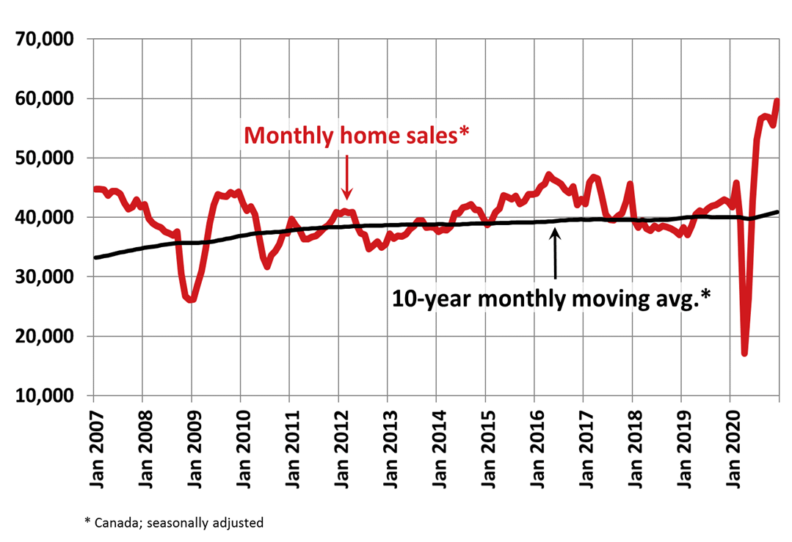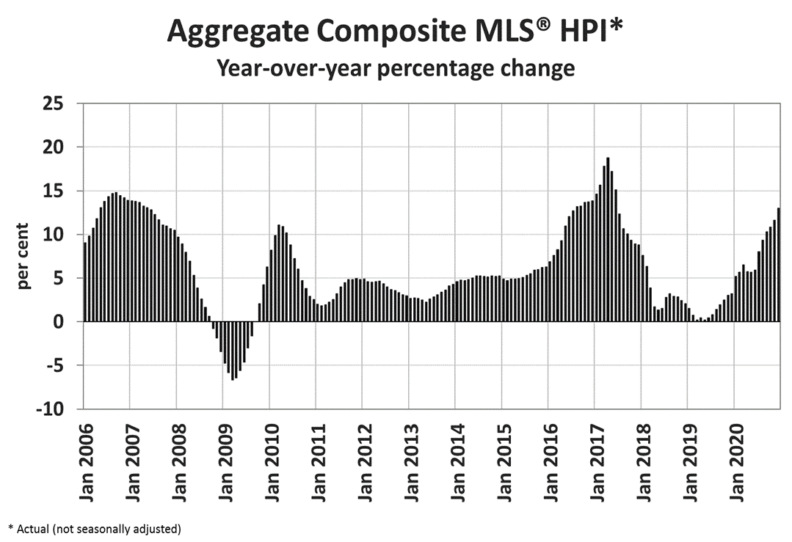Record December caps record year for Canadian home sales
Ottawa, ON, January 15, 2021 – Statistics released today by the Canadian Real Estate Association (CREA) show national home sales set another all-time record in December 2020.
Summary:
- National home sales rose 7.2% on a month-over-month (m-o-m) basis in December.
- Actual (not seasonally adjusted) activity was up 47.2% year-over-year (y-o-y).
- The number of newly listed properties climbed 3.4% from November to December.
- The MLS® Home Price Index (HPI) rose 1.5% m-o-m and was up 13% y-o-y.
- The actual (not seasonally adjusted) national average sale price posted a 17.1% y-o-y gain in December.

Home sales recorded over Canadian MLS® Systems jumped by 7.2% between November and December to set another new all-time record.Seasonally adjusted activity was running at an annualized pace of 714,516 units in December 2020 – the first time on record that monthly sales at seasonally adjusted annual rates have ever topped the 700,000 mark.The month-over-month increase in national sales activity from November to December was driven by gains of more than 20% in the Greater Toronto Area (GTA) and Greater Vancouver.
Actual (not seasonally adjusted) sales activity posted a 47.2% y-o-y gain in December – the largest year-over-year increase in monthly sales in 11 years. It was a new record for the month of December by a margin of more than 12,000 transactions. For the sixth straight month, sales activity was up in almost all Canadian housing markets compared to the same month in 2019.For 2020 as a whole, some 551,392 homes traded hands over Canadian MLS® Systems – a new annual record. This is an increase of 12.6% from 2019 and stood 2.3% above the previous record set back in 2016.
"It’s official, despite all the challenges, 2020 was a record year for Canadian resale housing activity,” stated Costa Poulopoulos, Chair of CREA. "While momentum continues into 2021, surging COVID cases and a return to April-like lockdowns in some provinces means we’ll be revisiting some of those virtual technology solutions to process deals in the first few months of the year. Hopefully we’ll have the current wave more under control by the time the spring market rolls around, which is shaping up to be a very active one. In the meantime, we will remain extremely vigilant, as we have all along, in adhering to government and health officials’ directives to keep our clients safe. Now as always, REALTORS® remain the best source for information and guidance when negotiating the sale or purchase of a home,” continued Poulopoulos.“The stat to watch in 2021 will be new listings, particularly in the spring – how many existing owners will put their homes up for sale?” said Shaun Cathcart, CREA’s Senior Economist. “We already have record-setting sales, but we know demand is much stronger than those numbers suggest because we see can see it impacting prices. On New Year’s Day there were fewer than 100,000 residential listings on all Canadian MLS® Systems, the lowest ever based on records going back three decades. Compare that to five years ago, when there was a quarter of a million listings available for sale. So we have record-high demand and record-low supply to start the year. How that plays out in the sales and price data will depend on how many homes become available to buy in the months ahead. Ideally we’d like for households to be able to find and acquire the homes that best suit their needs and for housing to remain affordable, but the fact is we’re facing a major supply problem in 2021.”The number of newly listed homes climbed by 3.4% in December, led by more new listings in the GTA and B.C. Lower Mainland, the same parts of Canada that saw the biggest sales gains in December.
With sales up by more than new supply in December, the national sales-to-new listings ratio tightened to 77.4% – among the highest levels on record for the measure. The long-term average for the national sales-to-new listings ratio is 54.2%.Based on a comparison of sales-to-new listings ratio with long-term averages, only about 30% of all local markets were in balanced market territory in December, measured as being within one standard deviation of their long-term average. The other 70% of markets were above long-term norms, in many cases well above.The number of months of inventory is another important measure of the balance between sales and the supply of listings. It represents how long it would take to liquidate current inventories at the current rate of sales activity.
There were just 2.1 months of inventory on a national basis at the end of December 2020 – the lowest reading on record for this measure. At the local market level, 29 Ontario markets were under one month of inventory at the end of December.
The Aggregate Composite MLS® Home Price Index (MLS® HPI) rose by 1.5% m-o-m in December 2020. Of the 40 markets now tracked by the index, only one was down between November and December.

The non-seasonally adjusted Aggregate Composite MLS® HPI was up 13% on a y-o-y basis in December – the biggest gain since June 2017.The largest y-o-y gains – above 30% at this point – were recorded in Quinte & District, Simcoe & District, Woodstock-Ingersoll and the Lakelands region of Ontario cottage country.
Y-o-y price increases in the 25-30% range were seen in Bancroft and Area, Grey Bruce Owen Sound, Kawartha Lakes, North Bay, Northumberland Hills and Tillsonburg District.
This was followed by y-o-y price gains in the range of 20-25% in Barrie, Hamilton, Niagara, Brantford, Cambridge, Huron Perth, Kitchener-Waterloo, London & St. Thomas, Southern Georgian Bay and Ottawa.
Prices were up in the 15-20% range compared to last December in Oakville-Milton, Peterborough and the Kawarthas, Montreal and Greater Moncton.Meanwhile, y-o-y price gains were in the 10-15% range in the GTA and Mississauga, and in Quebec City, and in the 5-10% range across B.C., and in Regina, Saskatoon, Winnipeg and and St. John’s NL. Price were up 1.5% and 2.7% in Calgary and Edmonton, respectively.
The MLS® HPI provides the best way to gauge price trends because averages are strongly distorted by changes in the mix of sales activity from one month to the next.The actual (not seasonally adjusted) national average home price was a record $607,280 in December 2020, up 17.1% from the same month last year.The national average price is heavily influenced by sales in Greater Vancouver and the GTA, two of Canada’s most active and expensive housing markets. Excluding these two markets from calculations cuts almost $130,000 from the national average price.